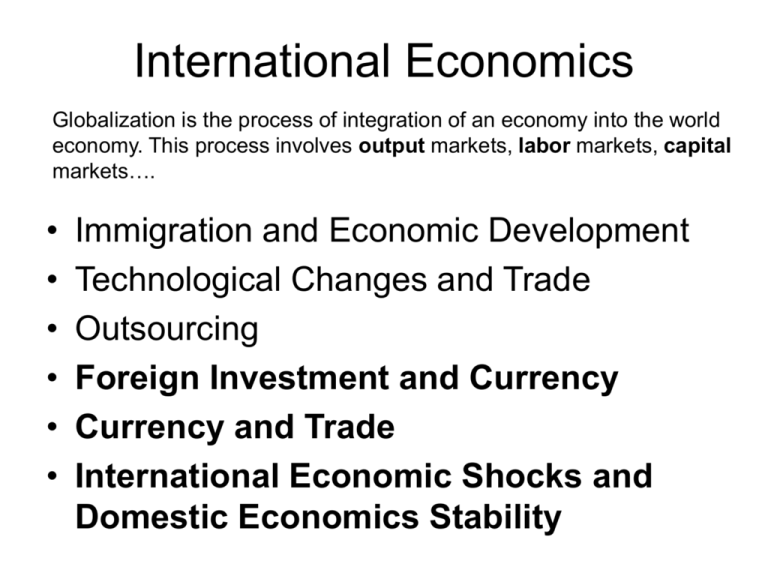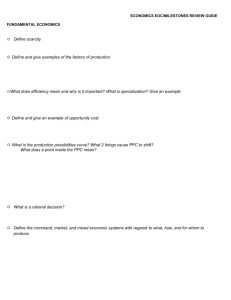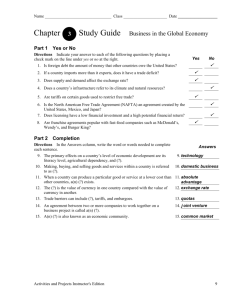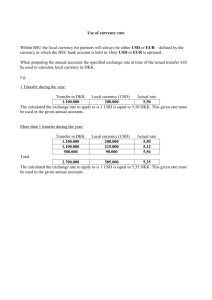International Markets
advertisement

International Economics Globalization is the process of integration of an economy into the world economy. This process involves output markets, labor markets, capital markets…. • • • • • • Immigration and Economic Development Technological Changes and Trade Outsourcing Foreign Investment and Currency Currency and Trade International Economic Shocks and Domestic Economics Stability International Finance International Markets I. ForEx Market (Currency) II. Capital Market (Investment) III. Market for Goods and Services (Trade) The planet Earth in the darkness of the night* * Image source: NASA (http://antwrp.gsfc.nasa.gov/apod/ap001127.html) ForEx Average Daily Volume of Bank Foreign-Exchange Market Activity (Source: Basel: Bank for International Settlements, September 2004) billions of dollars percentage share Spot 621 35 Swaps 944 53 Forwards 208 12 Total 1773 100 Defining the Market: Institutions facilitating the market: Major Private Banks Central Banks Market Participants: Banks, Central Banks, Corporations, Investors, even consumers. Brief History of the International Monetary System Gold Standard: 1880 - 1914 Dates of adoption of a gold standard •1695: United Kingdom at £1 to 113 grains (7.32g) of gold. •1818: Netherlands at 1 guilder to 0.60561g gold •1854: Portugal at 1000 reis to 1.62585g gold •1871: Germany at 2790 Goldmarks to 1kg gold •1873: Latin Monetary Union (Belgium, Italy, Switzerland, France) at 31 francs to 9g gold •1873: United States de facto at 20.67 dollars to 1troy oz •1875: Scandinavian monetary union: (Denmark, Norway and Sweden) at 2480 kroner to 1kg gold •1876: France internally •1876: Spain at 31 pesetas to 9g gold •1878: Finland at 31 marks to 9g gold •1879: Austria 1893: Russia at 31 Roubles to 24g gold •1897: Japan at 1 yen to 1.5g gold Price Stability Simplified conversion No Future markets 1918-1939 • Great Depression and lack of international cooperation • 1925 -1931 UK operates on Gold Standard • US remains on Gold Standard till 1933 • Fixed exchange system Post WWII era • Bretton Woods – IMF and the Gold Exchange Standard • Gold Exchange Standard – – – – – – Fixed system with limited (1% allowable adjustments) Dollar is convertible into gold at 35 USD per 1 Oz Very few monetary reforms are undertaken by member states 1950’s – 1960’s August of 1971 USD is no longer a convertible currency The Smithsonian Conference of December of 1971 • 38.02 USD = 1 oz • Dollar remains inconvertible • Increased allowable adjustment to 2.25% • March of 1973 FLOAT begins Spot market • http://www.federalreserve.gov/releases/h10/Update/default.htm • Ask and Bid prices and the spread – – – – • Ask – Bank’s asking (bank’s sales price) Bid – Bank’s purchase price Spread – return to the market maker, in this case the bank Consider the following rouble quote: Ask Price: $0.0425; Bid Price: $0.0420 Alignment of exchange rates – Arbitrage • • • – Simple setting (2 or more currencies): – Consider two banks quoting the rouble: » Bank I: $0.0425 - $0.0430. » Bank II: $0.0435 - $0.0440 Price difference falling within the spread Setting 2: implied exchange rate (3 or more currencies): – Consider tw banks providing the following quotes: » Bank I: Between Rouble and Dollar: R1 = $0.0425 Between Rouble and Euro: R1 = EUR 0.030 Implied USD/EUR rate is: USD1 = 0.7059 » Bank II Between Rouble and Dollar: R1 = $0.0425 Between Rouble and Euro: R1 = EUR 0.031 Implied USD/EUR rate is: USD1 = EUR0.7294 Are profits from arbitrage possible? Currency Index: USD Index by the FED Economy Euro area Canada China Japan Mexico United Kingdom Korea Taiwan Hong Kong Malaysia Singapore Brazil Switzerland Thailand Australia Sweden India Philippines Israel Indonesia Russia Saudi Arabia Chile Argentina Colombia Venezuela Total weight in percentage 1997 2003 17.49 16.92 6.58 14.27 8.5 5.73 3.68 3.77 2.65 2.25 2.87 1.82 1.43 1.59 1.31 1.22 0.88 1.18 0.84 1.25 0.78 0.8 0.53 0.61 0.49 0.58 100 18.8 16.43 11.35 10.58 10.04 5.17 3.86 2.87 2.33 2.24 2.12 1.79 1.44 1.43 1.25 1.16 1.14 1.06 1 0.95 0.74 0.61 0.49 0.44 0.41 0.3 100 change 1.31 - .49 4.77 - 3.69 1.55 - .56 0.18 - .90 - .32 - .01 - .75 - .03 0.01 - .16 - .06 - .06 0.26 - .12 0.16 - .30 - .04 - .19 - .05 - .18 - .08 - .27 0 USD weights Source: FED Source: FED Recent performance of the USD 1.8 $/Euro 1.6 1.4 1.2 1 0.8 0.6 0.4 0.2 Source: FederalReserve.gov: http://www.federalreserve.gov/releases/h10/Hist/ 1/3/2008 7/3/2007 1/3/2007 7/3/2006 1/3/2006 7/3/2005 1/3/2005 7/3/2004 1/3/2004 7/3/2003 1/3/2003 7/3/2002 1/3/2002 7/3/2001 1/3/2001 7/3/2000 1/3/2000 0 Role of the exchange rate in the price of oil USD Price of Oil $/Euro Euro Price of Oil 3-Mar-08 102.42 1.521 67.34 5-Mar-07 60.05 1.3094 45.86 6-Mar-06 62.46 1.2002 52.04 7-Mar-05 53.9 1.3203 40.82 8-Mar-04 36.53 1.2371 29.53 3-Mar-03 36.1 1.0835 33.32 4-Mar-02 22.55 0.8652 26.06 change in the price 79.87 % change (inflation) 354.1906874 41.27 75.7975 Source for historical oil price data – US Dept. of Energy, http://tonto.eia.doe.gov/dnav/pet/pet_pri_spt_s1_d.htm 158.36 The ForEx Market • Supply of the USD – Imports to the US • Goods (trade) • Services (tourism) – US investment abroad • Foreign Financial Markets • Direct investment abroad – Central Banks – Speculation • Demand for the USD – US Exports • Goods • Services (tourism) – Foreign Investment into US • US Financial markets • Direct investment – Central Banks – Speculation The Interesting 90’s • 1991-92: Collapse of the USSR Block, beginning of the Transitional Recession in Eastern Europe • 1994 Mexican Currency Crisis • 1991(2)-95 The Balkan Wars • 1998 Recession in Japan • 1997 (July) Beginning of the Asian Financial Crisis • 1998 major Rouble Crisis US ECONOMY average % rates 19922000 20012004 Real GDP 3.7 2.5 Gross Domestic Private Investment 8.7 1.8 Non-Residential Investment 9.1 0.2 The market for USD in the 90’s P of USD Influx of investment stimulated Demand D S Increase in imports stimulated Supply Demand Effect Dominated (thus positively effecting consumers’ standard of living) The post 90’s era • United Europe – 10 New Countries Entered the Union on May 1st of 2004, bringing the total number of member states to 25, with combined population of over 430 million (US population is 293 million). • Growth in Russia and China nearing double digits • Emerging Economies of Brazil and India • Threat of Terrorism to the US • Continuous Growth in US Trade Deficit The market for USD in the post 90’s era P of USD D S Supply effect appears to be dominating The demand effect The BIG picture • • • • Rise in Imports Increase in Supply Depreciation Rise in Exports Increase in Demand Appreciation Influx of Investment Increase in Demand Appreciation Outflow of Investment Increase in Supply Depreciation COMMODITY PRICES AND CURRENCY BEHAVIOR • Wheat and the Australian Dollar • Oil and the Russian Ruble Future Markets – forward looking instruments • Forward Rates • Swaps • Futures • Options Forwards • The transaction takes place at a future time period based on the previously specified terms (value and price) • Forwards can be used to predict future spot rates as they reflect expectations of currency traders • Forward premium versus forward discount Implications of forecasting and the forward transactions • • • • • Consider that R25 = USD1 today A 6 month forward rate is R25 = USD1 Forecast 1 predicts the future spot rate: R24 = USD1 in 6 months Forecast 2 predicts the future spot rate: R25.20 = USD1 in 6 months If our firm owes a payment to a Russian trading partner in 6 months from now then these two forecasts become confusing: – Based on Forecast 1 we should either purchase the ruble now – Based on Forecast 2 we should wait for 6 months and purchase the ruble then • If after 6 months the spot rate happens to be R24.9 = $1, the First forecaster proves to be the best in terms of policy recommendation, even though that forecaster has a much greater error. swaps • A swap usually is a trade that includes a spot and a forward transaction into one. • Some forward-forward swaps are also being used (both transactions are forward) • Frequently used between banks (including Central Banks) • Consider two banks: Citibank (US) and Lloyds (UK) – If Citibank needs pounds, it can agree to exchange dollars for pounds with Lloyds today and also agree to a reverse transaction at a future date – For example, if the spot rate is 2 USD per pound and the agreed forward rate is 2.10 dollars per pound than this constitutes a swap – In this case the pound is traded at a forward premium of $0.1, or 1000 basis points (a basis point is 1/100 of 1 %) in the forward market – A percent conversion can also be made: $0.10/$2.00 = 5%, if the swap is for 6 months, then this is equivalent to 10% rate of return for Lloyds Futures • Limited selection of currencies • Specified quantities • Traded on exchanges options • • • • • • Call versus put Expiration Volatility and risk premium Option use as a hedging tool (proper hedging) Option use as an income source (improper use) Option Pricing – the Black-Scholes model – Scholes won the Nobel Prize. Was a co-founder of the LTC venture along with another Nobel Prize winner Merton and a number of other prominent economists (from the FED, Salomon Brothers…). The LTC venture was one of the largest in history financial disasters when it collapsed in 1999, losing 5 billion dollars in about 4 months. – Recent behavior by some hedge funds Option value Risk premium = time value Option value = time value + intrinsic value Intrinsic value >0, otherwise no exercise Intrinsic value Option value strike Asset price Characteristics of hedge funds • Unrestricted in their behavior – May assume short positions – Trade options/features – May assume leverage (the Carlyle Capital hedge fund operated at a multiple of 32 http://dealbook.blogs.nytimes.com/2008/03/14/in-carlyle-collapse-a-lesson-for-bear-stearns/ the Bear group operated with a 34 times equity leverage) • Note, not all hedge funds leverage themselves, after all, hedging is a protective tool, not a speculative tool Basic option strategies • • • • • • • • Options can be purchased or written (sold short) Hedging – use of options for insurance purposes Covered call (hedging) Covered put (hedging) Naked call (infinite risk) Naked put (limited risk) Spread (risk depends on the structure) Straddle (market movement) Leveraging – the inappropriate behavior • Obtain investment • Magnify it by using it as a collateral to borrow money in a low interest rate environment (say Japan) • Magnify the funds further by issuing naked puts (possibly calls) • Use the funds to go into relatively safe investment vehicles that earn income – US Treasury bonds (short term will typically require 5 - 10% margin requirement only) What if markets don’t behave the way you expected? • If you are leveraged - CRASH – The Carlyle group in March of 2008 • Can the markets behave in an unpredictable way? – BSC stock moved from $159 on 4/25/07 to $2.84 3/17/08, could that have been predicted from the past distribution of prices of BSC? – The LTC venture • The Asian Crisis • The Rouble Crisis • Could the full extend of these crises have been predicted in advance? – The Carlyle Group • The US housing market (see the next slide) The Housing Market Median Home Price 2005 2006 2007 2007: QIV US 219,000 221,900 217,800 206,200 Atlanta, GA 167,200 171,800 172,000 164,300 Sacramento, CA 375,900 374,500 342,700 297,600 99,000 97,900 104,000 105,400 256,100 254,800 269,700 278,800 Buffalo, NY Atlantic City, NJ Home Sales in the US decreased from 6,380,000 in 2006 to 4,890,000 in 2007, suggesting that the quantity decreased along with the price – characteristics of a demand pull back (http://www.realtor.org/Research.nsf/files/MSAPRICESF.xls/$FILE/MSAPRICESF.xls ) Revisiting the ForEx Market • Nominal exchange rates versus Real exchange rate – Real Exchange rate • Er = En * (Pd)/(Pf) • Law of one price – Undervalued versus overvalued exchange » Real exchange rate must be equal to one – Economic agents respond to real changes • Redistribution of wealth within the country – Appreciating dollar in the 1990’s and the impact on the “rust belt” of the US – Appreciating Canadian Dollar and the redistribution of wealth across the Canadian provinces • Prices act as signals of information – Frequent changes may produce incorrect signals Purchasing Price Parity • Absolute – Internationally traded goods – Limited trade restrictions (natural and artificial) – The law of one price: Pd = E * Pf • The Big Mac index • Commodity prices • Cross-border trade with Canada – International trade as the corrective mechanism – Implications: • Nominal exchange rates change to offset changes in the price levels, but the real exchange rate remains constant • Relative – Role of inflation – International trade as the corrective mechanism – Nominal exchange rate movement as the differential in the inflation rates • Deviations from PPP – Non-tradable goods – Heterogeneity of goods and consumer demand – Trade restrictions • Current export restrictions on grain (Kazakhstan) • Russian Export tariffs • Import tariffs Relative prices and the exchange rate • Rise in the price of a heavily consumed product can lead to currency appreciation • Rise in the price of a product that is being exported (and the foreign demand is inelastic), can lead to currency appreciation Fixed Exchange Rate • Overvalued – – – – Current account deficit Possibility of currency attack Loss of reserves Russia, 1998 • Undervalued – Current account surplus – Accumulation of reserves – Effectively, monetary expansion is caused at the forex window of the CB Capital Movements and the ForEx market • Interest Rate Parity – Money follows the highest risk adjusted rate of return, thus a rise in the interest rate will cause an influx of foreign investment, all else held constant • Recent depreciation of the USD • Canadian Central Bank behavior in light of US rate reductions • Uncovered interest rate parity – No forward market cover transaction – Ex: 2006-2007 US hedge funds’ borrowing in Japan • Covered interest rate parity – Covered with a forward transaction to exit the currency Uncovered interest rate parity US Japan interest rate i$ iY starting balance A A*Ex Ex = Yen per USD balance after investing A*(1+i$) A*Ex*(1+iY) in equilibrium, the returns should be the same A*(1+i$) = A*Ex(1+iY) (1+i$)/(1+iY) = Ex taking natural log and differentiating gives us the relationship between the exchange rate and the interest rate Covered interest rate parity US Japan interest rate i$ iY starting balance A A*Ex Ex = Yen per USD balance after investing A*(1+i$) A*Ex*(1+iY) Balance after covered exit A*(1+i$) A*Ex*(1+iY)*(1/Fx) Fx = forward rate, Yen per USD in equilibrium, the returns should be the same A*(1+i$) = A*Ex(1+iY)(1/Fx) (1+i$)/(1+iY) = Ex/Fx to simplify the equation, subtract 1 from each side (i$-iY)/(1+iY) = (Ex - Fx)/Fx Interest Rate Parity • Movements of the government bond rates • Actions of the Central Banks • Expected future return and the real interest rate (investment into Russia today, due to commodity pricing) Balance Of Payments • Summary of all international transactions • Current Account – US trade deficit and the outflow of foreign exchange (dollar is the international reserves currency) • Financial Account – US borrowing from overseas and the inflow of foreing exchange – Paying for trade deficit, the US style • Reserves Account – Choice of exchange rate regime Balance of Payments and the Choice of the Exchange Rate Regime • Float – USA (trade deficit) • Fixed – Russia, 1998 (Currency Crisis) Economic Stabilization Policies and the choice of the exchange rate regime • Monetary Policy • Fiscal Policy Monetary Side of Economy Money • Properties of Money – Store of Value – Unit of Account – Medium of Exchange • Fiat money versus Commodity Based money – Gold Standard Supply of Money • • • How to measure money? Defining supply of money based on liquidity M1 – most liquid assets (in Dec of 2007 - 1364.2 billion $) – Cash – Demand deposits (all forms of checking accounts) – Traveler’s checks • M2 – less liquid than M1 (in Dec of 2007 - 7447.0 billion $) – – – – – • M1 Retail money market mutual fund balances Savings accounts Money market accounts Small time deposits (CDs) M3 – – – – – M2 Large time deposits (CDs in excess of 100K) Repurchase agreements Eurodollars Institution-only money market mutual fund balances Statistical Source: http://www.federalreserve.gov/releases/h6/Current/ Demand for Money • Transaction demand – Function of income • Opportunity cost of holding money – Function of the interest rate Quantity theory of Money the long-run role of money • Money x Velocity = Prices x Transactions • Noting that transactions are based on the level of real GDP, we can rewrite the above: • M x V = P x Real GDP • Assuming constant velocity of money: • Inflation = money supply growth – real output growth • The above provides us with the fundamental look at inflation • Examples: – Russia in 1990’s – Germany in the post WWI era Other Causes of Inflation • Resource supply shock – USA and the oil price today – Reduced supply of cheap foreign labor and the US inflation today • Demand driven overheating – Operating at unemployment rates below the natural unemployment rate – USA in 2000 • Expectations of future price increases Impact of inflation unexpected versus fully anticipated inflation COSTS • • • • Menu cost Uncertainty Ability of inflation to reduce forward looking financial arraignments Redistribution of wealth • Impact of inflation on banks: – Banks are short-term borrowers, long-term lenders. • Rise in inflation increases borrowing costs (recall the Fisher equation) BENEFITS • Reduced real wages (effectively enables fixed [sticky] wages to become flexible, the long-run adjustment) Hyperinflation • Really high – Russia 1990-1995 • Sources – Typically: Monetary Expansion • Effects – May lead to dollarization Modern Banking System and Money Creation • Fractional Reserve System – Required Reserves – Excess Reserves • Money Creation Process – Multiplication – Potential money multiplier – Actual money multiplier • Reserve Requirements as a monetary policy instrument Monetary Policy Today US example • Central Bank – FEDERAL RESERVE • FOMC – Policy Making Body – Meets typically 8 times a year • Policy Objectives – Economic stability and growth • Real GDP, Employment, Inflation • Policy Mechanism – Interest Rate • Real GDP is a function of the Interest rate – Investment is a function of the Interest Rate – Consumption is a function of the Interest Rate – Interest Rate is a function of the Supply of Money • Market for Loanable Funds • Interest Rate as the price of Money Monetary Policy In Action • Reserve Requirements Ratio – Current structure based on size of liabilities http://www.federalreserve.gov/monetarypolicy/reservereq.htm • Discount Rate • Open Market Operations – Federal Funds Rate • Term Auction Facility (introduced in 2007) Policy Impact • Domestic response in the GDP – Consumption Spending – Investment Spending (2001-2003 and the housing market) • International response – Currency depreciation in the case of expansionary monetary policy (USA today) – Response of exports/imports to currency depreciation impact on the GDP • Impact on Prices Monetary Policy • Floating exchange rate regime: – Monetary expansion leads to currency depreciation • Fixed exchange rate regime: – Monetary policy is ineffective (EU12) Fiscal Policy • Floating exchange rate regime – Currency appreciation makes fiscal expansion ineffective • Fixed exchange rate regime – Fiscal expansion leads to monetary expansion







